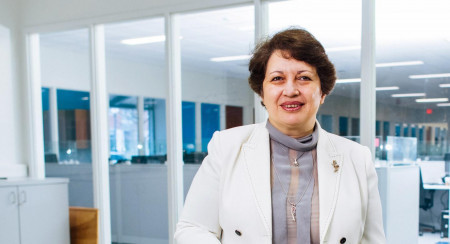
Professor Naira Havakimyan is heading up research to evolve autonomous air mobility. Image Courtesy of UIUC
Latest News
May 2, 2022
Think the idea of a flying taxi is a pipe dream? If a professor at the University of Illinois Urbana-Champaign (UIUC) has her way, the stuff of science fiction may soon be a reality, buttressed by a new NASA-funded center along with university and industry partnerships.
Naira Hovakimyan, professor of mechanical science and engineering at UIUC, has won a $6 million NASA grant, awarded through the NASA University Leadership Initiative (ULI), to establish the Center for Autonomous Vehicles in Air Transportation Engineering (AVIATE) at the university. The grant is one of four ULI grants distributed in 2022. Hovakimyan is working with other colleagues in the Mechanical Science and Engineering (MechSE) at UIUC as well as partner researchers from MIT, Georgia Tech, North Caroline A&T, and the University of Nevada at Reno along with industry partners from Lockheed Martin and Sierra Nevada Corp. as part of a multidisciplinary team devoted to solving the flying taxi challenge.
Hovakimyan has been evolving an L1 adaptive flight control system for years, an innovation that ensures maneuverability and safety in airplanes and has proven to outperform human pilots in challenging conditions. Blending Hovakimyan’s work with that of her colleagues and partners, the team is aiming to develop a robust and resilient autonomy framework, complete with verifiable architectures, to address the uncertainties and off-nominal situations and enable what they are calling “safe and efficient Advanced Air Mobility.”
Because such a category of systems have complex, nonlinear dynamics and are subject to environmental uncertainties resulting from modeling inaccuracies, physical failures, and external disturbances, there is a need for a competence-aware perception-planning control framework with learning-enabled controls, according to AVIATE’s charter. The goal is to enable vehicles in this class to perceive the environment, interact with other entities, make predictions about resulting behaviors, and adjust accordingly. The process is akin to what pioneers and a nascent industry are formulating with their work on autonomous land vehicles.
Other UIUC research involved in the project includes Simplex architectures, robust perception technologies, and fault detection and reliability analysis emanating from different university engineering disciplines.
AVIATE’s work is critical to making this class of small autonomous aircraft a trustworthy mode of transportation, Hovakimyan says. Because there aren’t the same obstacles in the path of a flying taxi compared to an autonomous car, Hovakimyan says this emerging category of vehicle could spring to life sooner than autonomous land vehicles. “On the road you have pedestrians, other vehicles, and much more unpredictability,” she explained.
Establishing AVIATE at the university will also help students gain experience working in multidisciplinary teams and potentially bring in underrepresented student populations who haven’t applied their skills to solving these kind of aviation problems, Hovakimyan said.
Watch this video to hear NASA engineers talk about a vision for urban air mobility, including flying taxis.
Subscribe to our FREE magazine, FREE email newsletters or both!
Latest News
About the Author
Beth Stackpole is a contributing editor to Digital Engineering. Send e-mail about this article to [email protected].
Follow DE




